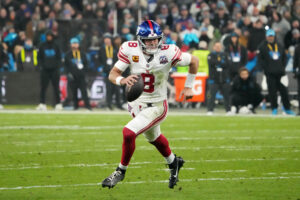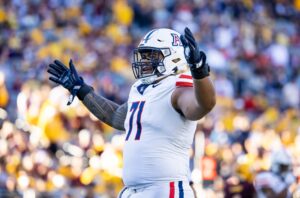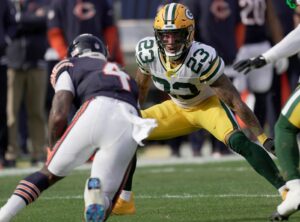Over the past several weeks, the NFL has been gradually releasing its “top 100 players of 2017.” What makes this list unique is that it’s the players themselves who vote on which individuals they think are the biggest standout stars. The league polled over 900 current players to come up with the rankings.
There are elements of this list where the consensus between players, analysts and fans is overwhelming. After the season he just put together, it’s hard not to put Tom Brady at the top regardless of the fact that his 40th birthday is fast approaching. And apart from some hand-wringing over a position or two, the top ten is fairly spot on. It’s hard to deny that players such as Von Miller, Julio Jones, Antonio Brown, Khalil Mack, Aaron Rodgers, Ezekiel Elliott, Odell Beckham, Jr., Le’Veon Bell and Matt Ryan deserve recognition as the best this league has to offer.
But one player, perhaps above all 99 others, is grossly underrated on this list. His abysmally low position on it speaks to the inherent flaws associated with these kind of rankings. Yes, they generate debate. Yes, they most definitely generate Internet traffic. But they can also massively undersell a player’s talent and overall worth to his team. And this year, there is no bigger example than Andrew Luck.
Andrew Luck Doesn’t Get Enough Credit From His Peers
Luck comes in at number 51 in this year’s rankings. At first glance, that doesn’t seem too overly critical of him. After all, the Indianapolis Colts went 8-8 in 2016 and missed the playoffs for the second straight year. And he comes into next season two years removed from an injury-plagued 2015 campaign where he missed the final nine games of the season.
But there are plenty of reasons why Luck not even making the top 50 is off-base. Even more absurd is the significant distance between him and a handful of quarterbacks that are much less proven over the course of their careers. Add to that the preposterousness of him trailing certain other signal callers in these rankings and the perfect storm is there to take them in their entirety with a grain of salt.
The case is certainly there that Luck is under-appreciated among his peers. Given this is a players only ranking, it’s a fairly accurate assessment of how said players feel about those exceptional talents in the league. Below are a few examples of why Luck deserves a little bit more love than he’s getting.
It’s Not Like He Was Terrible Last Year
The Colts didn’t exactly light the NFL ablaze with their overall play in 2016. A cursory glance at their final position in the standings serves as a reminder of that notion. They finished third in an extremely mediocre AFC South that the Houston Texans won for the second year in a row with a 9-7 record.
But let’s be honest. Luck deserves a limited share of the blame at best for that lack of success. His 31 touchdown passes ranked as the second highest effort of his career. Only four quarterbacks managed more last season including the two who eventually contested the NFC Championship. And his 13 interceptions equaled those of Ben Roethlisberger, the eventual runner-up quarterback in the AFC.
Luck’s effectiveness at throwing downfield continued to shine. He finished the regular season averaging 7.78 yards per attempt, the fifth-best total in the league. He commanded a Colts passing game which maintained a high level of production. His 283 yards per game also ranked number five among NFL signal callers.
Situationally, he remains among the most dynamic players at the position. Not only did he finish with a 71.2 Total QBR in 2016 (seventh in the league), Pro Football Focus gave him a grade of 92.4. Only three other quarterbacks (Brady [99.3], Ryan [93.5] and Rodgers [93.3]) received grades of 90 or higher. His QBR number exceeded that of six quarterbacks ranked ahead of him on this top 100 list while his PFF grade was better than eight of them.
Luck Perseveres Despite Continued Offensive Line Ineptitude
History continues to prove that a key ingredient to any Super Bowl run is a competent offensive line. Even an elite quarterback can only do so much when he’s constantly under pressure and running for his life. Perhaps the biggest component to the Patriots remaining in the Super Bowl picture as Tom Brady enters his 40s is solid play from the big boys in front of him.
Luck was the beneficiary of solid O-line play during two of his first three years in the league. It included the Colts averaging 1.6 sacks allowed per game in 2014, which ranked fourth best in the NFL. Is it any coincidence, then, that Indy made it all the way to the AFC Championship game that year before falling to the eventual Super Bowl XLIX champion Patriots?
But suffice it to say that Luck’s offensive line regressed afterwards. Part of it stemmed from the fact that then general manager Ryan Grigson did little if anything to build on the unit after the success of 2014. It resulted in an experienced offensive line lacking depth the following year. Though Grigson drafted three linemen in 2016, the unit remained a work in progress.
That notion remained an incontrovertible truth at season’s end. The Colts O-line allowed 44 sacks and 128 quarterback hits last year, both of which were no better than fifth worst in the league. Luck’s 41 sacks suffered were tied with Andy Dalton and Russell Wilson for second most among quarterbacks. In part, it’s why the Colts replaced Grigson with Chris Ballard in the off-season.
The following chart is another indication of how much the Colts offensive line struggled. It ranks the top 20 units in the league based on the average PFF grade across all positions on the line. It either includes primary starters at each position or the average of players who shared reps.

Two things are evident. Firstly, seven of the top 11 offensive lines according to this data made the playoffs last year. Second, the Colts line has some work to do if if wants to play its part in the Colts postseason ambitions in 2017. The unit does boast a few promising young players in Jack Mewhort and Ryan Kelly. But by and large, there’s plenty of room for improvement moving forward.
Comparing Luck’s Body of Work to Certain Quarterbacks Ranked Ahead of Him
If there’s anything to take away from these rankings, it’s that NFL players think there are 11 quarterbacks in the league better than Luck right now. A few are glaringly obvious. Nobody (I hope) is going to put Luck ahead of players such as Brady, Brees, Rodgers, Roethlisberger and Wilson, all of whom have at least one Lombardi Trophy to their credit. And even Cam Newton has a Super Bowl appearance and MVP award to his name.
All of the aforementioned names also appear poised to continue playing at a high level, even the elder statesmen in Brady and Brees. So if the rankings are a snapshot of player expectations in 2017 rather than a broad assessment of their career to this point, those two belong among the best. But Luck does too. He overcame shoddy offensive line play in 2016 to remain among the league’s most dynamic passers. Watch the film. Peruse his stats. They both confirm that indisputable notion.
What’s also not up for debate is the fact that Derek Carr and Dak Prescott turned in amazing seasons in leading the Oakland Raiders and Dallas Cowboys respectively to the playoffs. In Carr’s case, his MVP caliber campaign helped the Silver and Black erase a 13-year playoff drought. And his brand spanking new five-year, $125 million contract extension is well-deserved and he will most definitely earn it in the coming years.
But Carr and Prescott certainly benefited from their offensive line. The PFF data presented above is proof of that. Eight of ten starters on the Raiders and Cowboys front five garnered a score of 80 or better from PFF. If we add Marcus Mariota‘s line in Tennessee, that number expands to 13 of 15. All three deserve credit for compiling winning seasons, and the Titans just missed out on the playoffs in the AFC. But put Luck behind those offensive lines and you’re not going to see a drop-off in performance at the quarterback position.
If this discussion further incorporates body of work, the discrepancy between Luck and a few of the quarterbacks ahead of him on this list becomes even more spurious. The average ranking of Carr (11), Prescott (14), Matthew Stafford (31) and Mariota (50) is 26.5. That’s 24.5 spots ahead of Luck. This is the same Andrew Luck with three career playoff wins. That’s three more than Carr, Prescott, Stafford and Mariota combined.
Conclusion
These annual NFL top 100 rankings generate much debate and certainly get media and fans kicking their hot takes into overdrive. What separates them from others is that it’s those actually playing the games who weigh in. Nevertheless, it’s an inexact science that lends itself to knee-jerk reactions. Look no further than an elite quarterback of Luck’s caliber finding himself behind 50 NFL players despite putting up some of the best numbers of his career. And in all seriousness, he deserves better from his fellow NFL competitors.






